Toastul is the whimsical art of creating imaginative toasts. It combines elements of visual art, creative writing, acting, baking, and humor into a unique culinary performance art. While virtually unheard of just a decade ago, toastul has recently emerged as an intriguing creative outlet for artists, bakers, and toast enthusiasts around the world.

A Brief History of Edible Art
Humans have expressed themselves creatively through food for millennia, from elaborate ancient Roman feasts to ornate wedding cakes. However, creating art that is meant to be eaten, rather than merely complemented by food, is a more recent development. Here is a brief overview:
- 1600s – Edible centerpieces and architectural confections emerge in Italian and French royal courts.
- 1893 – The phrase “art for art’s sake” is first used, influencing artists to explore creativity purely for creative expression rather than functionality. This ideological shift later influences edible artists.
- 1960s – Feminist artists like Judy Chicago use food as an ephemeral art medium to explore gender roles and power dynamics.
- 1970s – With the rise of postmodernism, edible art comes into its own as artists mix culinary and visual arts.
- 1980s – Ronald Benner creates sculptures using cheese and butter. Jim Victor crafts watermelon bears.
- 1990s + Today – Edible art gains mainstream popularity through television shows, public exhibitions, and social media.
From Renaissance-era butter sculptures to modern rainbow grilled cheese sandwiches, we have used food as a creative medium for expression for ages. Toastul is simply the latest incarnation of this artistic impulse.
Defining Toastul
Toastul is the craft of using toasted bread as a foundation for imaginative culinary performance art. Toast artists, known as toastuls, use a combination of:
- Bread selection and toasting
- Toppings, decorations, and embellishments
- Custom branding and naming
- Theatrical presentation and performance
To create one-of-a-kind edible artworks that are part food, part art, part theater, and part comedy. The finished pieces frequently portray pop culture characters, make political statements, or convey emotions and experiences.
Notable Pioneers of Toastul
While chefs havelikely crafted artistic toasts for ages, several artists are credited with elevating toast-making into a legitimate art form complete with worldwide exhibitions and serious critical analysis. They have also coined delightful terminology to describe their craft.
Mimi the Toast Muse
- Australian artist who began creating edible portraits on toast in 2010 under the alter ego “Mimi the Toast Muse.”
- Hosts sold-out exhibitions featuring flamboyantly decorated toasts she calls “Toastscapes.”
- Published a book entitled “The Art of Toast” in 2015 highlighting her most notable toast creations.
- Credited with coining the terms “toastist” and “toastul” to describe artistic toast creation.
Adam Lee
- New York mathematician turned full-time toast artist who creates pop culture-themed “Tbstrosities.”
- Massive online following with millions of views of his YouTube series “Fun with Toast” showing him transform limp bread into everything from Homer Simpson to sushi feasts.
- Creator of a toasted replica of Leonardo da Vinci’s Mona Lisa that sold for over $10k at auction.
Laura Hadland
- British beer expert who combines her passion for brews with her flair for artsy toast to create one-of-a-kind pieces.
- Famed toast creations include an homage to David Bowie, a realistic cat toast, and a poignant COVID vaccine toast.
- Competed on Season 12 of Britain’s Great British Bake Off television show.
While their styles differ greatly, these toast innovators similarly recognize the creative possibilities in such a simple foodstuff. Their unique forms of toastul have undeniably influenced the global development of toast as an artistic medium.

Not Just Crunchy Paintbrushes: Key Aspects of Toastul
Like any art form, toastul contains key elements and techniques that distinguish it from merely making fun snacks. True toastul intentionally incorporates artistic consideration paired with culinary craftsmanship.
Bread Selection
Sourdough, rye, whole wheat, white, gluten free – the foundation of any toast creation significantly impacts its aesthetic qualities. Toastul artists consider factors like shape, color, texture, and mouthfeel when selecting bread styles to suit their desired final piece.
Craftsmanship
Artistically-slathered blobs of condiments on a piece of burnt bread does not toast art make. Creating museum-worthy toast requires precision knife skills to carve intricate designs, artful arrangement of colors and textures, and impeccable execution of culinary techniques from flavor balancing to spread consistency.
Concept and Message
All visual art contains underlying meaning; so too with toastul. Whether celebrating cultural icons, making political statements, or exploring difficult emotions, toastul artists infuse original symbolism and imagery into their edible medium based on their artistic motivations.
Theatrics
Playing into our human fascination with food, toast creators build anticipation and excitement by live-crafting their toast creations in front of audiencesor documenting their elbow-grease via time lapses. This performative aspect allows the audience to engage with toastul as an experience beyond a static art object.
Clever Branding
A sriracha-slathered piece of rye stamped with some Pepper Jack cheese does not an appetizing appetizer make. In contrast, call it “The Fiery Dracula” bruschetta and it seems infinitely tastier. Giving each toast creation an catchy name and backstory helps establish it as an intentional artwork rather than random snack.
When combined skillfully, these key factors elevate humble toasted bread into an evocative and technically complex ephemeral art form that both challenges and delights toastul artists and audiences.
Toast in Public: Notable Toast Art Exhibits
Once relegated to quiet breakfast tables or boozy bar nibbles, artistic toast creations have become celebrated centerpieces at acclaimed art institutions and mass media events over the past decade.
Museum Shows
Toastul has headlined exhibitions focused on the intersection of food, art and design at museums like:
- Victoria & Albert Museum, London – Multiple toast artists featured
- National Museum of Women in the Arts, Washington D.C. – Mimi the Toast Muse solo show
- Tatton Park Biennial Food Fair, England – Laura Hadland toast showcase
Television / Media
Eye-catching edible toast portraits have also been created live or displayed on international television programs including:
- Britain’s Great British Bake Off – Laura Hadland crafted headers depicting British icons during bread week
- The Late Late Show with James Corden – Host James Corden face-off with toast artist Adam Lee
- The Today Show Australia – Featured Mimi the Toast Muse preparing artistic toasts
This mass media exposure has introduced toastul to the general public as a legitimate – if whimsical – art form.
Emotional Edibility: Why We Connect with Toast Art
There is an innate human attraction to anything miniature. Scientific American suggests this draw to small objects taps into our affection for things that evoke nurturing, like babies or puppies. The toast canvas perfectlycaptures this “aww!” reaction — it’s just so adorable! And the urge to take a bite only intensifies this emotional reaction.
Beyond tickling our cute response, here are some theories on why toastul resonates so strongly:
Approachability – Toast is familiar and unintimidating, allowing viewers to feel immediately engaged rather than bewildered by shocking avant-garde styles.
Nostalgia – Humble toasted bread evokes childhood memories of beloved snacks. Playful toast tributes to cultural icons especially appeal to millennial and Gen Z nostalgia.
Relatability – Seeing ordinary objects transformed into art is instantly understandable. It gives viewers permission to see their daily world through a creative lens.
So while crisp surfaces and crumbly texturemake toast conveniently paintable, it seems this sense of warmth, whimsy and nostalgia baked into toast gives it its true binding power to attract and connect art aficionados and novices alike.
Get Creative with Toast : Tips for Aspiring Toast Artists
Want to try your hand at this innovative art form? Follow these tips to get started:
1. Gather Your Materials
- Bread (baguette, sourdough, whole grain)
- Knives (serrated, paring)
- Toppings (nut butters, jams, cheeses)
- Decorations (herbs, pickled veggies, bacon bits)
- Tools (toothpicks, squeeze bottles)
- Heat source (toaster, oven)
2. Find Inspiration
Flip through art books, explore emoji, walk through nature, or analyze dreams to develop a creative concept. Reflect on your life experiencesto uncover a meaningful theme.
3. Refine Your Skills
Take an art class to hone your precision with color, texture, shape, and dimension. Brush up on toast fundamentals by mastering grilling techniques, achieving even Golden browning, and balancing flavor profiles.
4. Establish Your Style
Make multiple test toasts while intentionally varying textures, palettes, shapes, and decorative elements to discover preferences. Analyze reactions to refine a signature style.
5. Stage a Performance
Dramatically unveil your toast creation to an eager audience. Share your artistic inspiration, discuss symbolism, bestow a clever name upon your piece. Photograph their reactions taking that first crunchy bite!
Frequently Asked Questions About Toastul
What are the most popular styles of toast art?
Pop art-inspired pixelated video game characters and celebrities reconstructed with herbs, spices, and condiments seem to gain significant media coverage and social media virality. Hyperrealistic animal shapes made from carved creamed cheeses also draw attention.
Can you make money as a professional toast artist?
A small handful of artists like Mimi and Adam Lee have achieved international fame and published books featuring their toast creations. They likely earn income through toast exhibitions, brand partnerships, private clients, and book proceeds. However most toastul remains an art for personal enjoyment rather than salary.
Does toast art taste good?
While stunning to the eye, some toast creations seem dubious for actual eating once constructed. However toastists insist that visual appeal never outweighs flavor balance and aim for their pieces to taste as good as they look. Some works even specifically intend to symbolize or evoke a certain smell or taste via associative textures and ingredients.
What makes toast such a great art medium?
The blank canvas of toasted bread provides an ideal pristine background for colorful ingredients. Toast’s sturdy-yet-pliant texture allows spreading, piping, and sculpting. And contrasting crispness against soft toppings creates visual interest. The combination of sculpture, paint — and appetizing aromas — gives toast unique appeal.
How can I get started with toast art at home?
Begin simply by creating emoji faces from sliced cheeses and pepper flakes or elegant patterns from berry compotes and jam. Progress to more refined, purposeful designs with every slice. Explore varied bread bases, embrace imperfections, find inspiration everywhere, and above all — have fun! Crumbs happen in this delicious emerging art medium.




